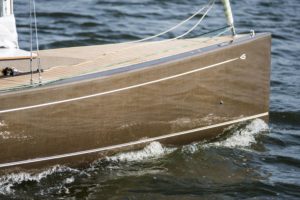 Glass and carbon fibres are commonly used to manufacture high strength composites. These “advanced composites” have revolutionized the world of materials by providing very resistant but light materials replacing metals
Glass and carbon fibres are commonly used to manufacture high strength composites. These “advanced composites” have revolutionized the world of materials by providing very resistant but light materials replacing metals
Originally developed for defense applications, composite technology has now become omnipresent and has been used in the nautical sector for many years. Composites offer excellent mechanical properties and durability (no rust), but commercial fibers and resins (plastics / polymers) derive from oil.
This creates problems, both because at the current consumption rate the duration of the deposits will not be very long, and because most of the composites (and plastics) produced by oil are not degradable in normal environmental conditions. very small fraction of these compounds is pulverized and used as a filler or incinerated, most end up in landfills at the end of their life. In anaerobic conditions such as landfills they last for several decades if not centuries, without degrading, making the land unusable. Incineration produces large quantities of toxic gases that require expensive washing. Both remediation and incineration, both expensive, are undesirable from an environmental point of view.
Flax27: natural fibers come aboard
It is now many years that yacht builders are considering and using natural composites, initially for molding internal components such as headliners, furniture, finishes, walls and doors, lately to build structural parts.
With the flax fiber composite, focusing on the sustainability of the marine construction, Friedrich Deimann, a young boat builder from Bremen has done much more.
He has experimented and developed for years a material alternative to GFRP: the linen fiber composite. He uses composite material based on flax fibers and epoxy resin of linseed oil. 60% of the resin is of natural origin and offers a complete replacement for mineral oil based epoxy resins.
Fredrich believes in a greener future, his and the Green Boats team’s enthusiasm and his constant commitment to the sustainable construction of boats have earned him visibility and esteem among boat builders.
His boats are green in every sense, (not only in the structure) such as the Boat 24 built with materials tested at the Bionics Innovation Center (BIC) of the University of Applied Sciences in Bremen.
A journey started as a teenager with a passion for the sea and nature that led him to build the first kayaks and a 4.5 m skiff in collaboration with Speedwave, 25 kg lighter than the standard series version. And then came the interior of Bente 39 for which a PET sandwich core was mainly used.
In 2017 with GreenBente24 Friedrich won the 2017 Ocean Tribute Awards at the Biocomposites Conference in Cologne for “his services to sustainability in boat building. The boat has the same weight and stiffness as a standard boat while achieving a 80% reduction of carbon footprint compared to other options, is thermally recyclable and has a particularly pleasant living climate”.
At the Düsseldorf Boot Show 2019, the green team presented Flax27, a daysailer, obviously green!
The boat is built in flax fiber composite, i.e. from flax fibers instead of glass fibers and green epoxy resin, based on vegetable oil, recycled PET for sandwich. The bridge is made of recycled cork from Portugal produced from the waste from the production of wine cork.
The mast is made of recycled aluminum because it is the most sustainable solution for its durability and recyclability, even if the production is energy-intensive and pollutes the environment. The daysailer was very successful because it is truly innovative and has aroused great curiosity among both the public and the builders.
The peculiarity of the Flax27 is the aesthetic. This means that there is no colored gel coating, but linen mats can be seen with a clear finish. Every single fiber is visible under the clear gel coating. In reality, it is not just the look: the laminate of the daysailer is not made by glass mats, but by spun and woven linen fibers with a foam core made of recycled PET. Everything is connected by a relatively environmentally friendly epoxy resin; part of the resin is vegetable and not derived from oil. Of course this peculiar aspect comes with a price, because in order for flax reinforcement to be so nice looking, special attention must be paid during lamination increasing costs.
However, nothing is left to chance at Green Boats to develop the materials and bring the products into series production. They founded Weserverbundwerkstoff GmbH. A group made up of Green Boats, Judel and Vrolijk, who design the material, the bio department of the University of Applied Sciences in Bremen and the Fraunhofer Institute.
Greenboats produces a range of marine and industrial products using 100% renewable and sustainable raw materials in sandwich structures. He developed the materials for the Flax 27, designed by naval architects Judel / Vrolijk & Co. The hull, deck and internal structure of the ship were infused with Sicomin’s GreenPoxy InfuGreen 810 resin and fabrics of reinforcement in flax fiber. The vacuum infusion with this resin produced transparent natural fiber laminates with improved mechanical properties.
Outside the marine sector there are application areas in the caravan and in the leisure industries that can be covered. Often clients ask the Company to make they products with the green materials.
Friedrich hopes that in the future more and more companies will choose to work with environmentally friendly materials such as flax fiber composites and is available to share his experience in the construction sector.







